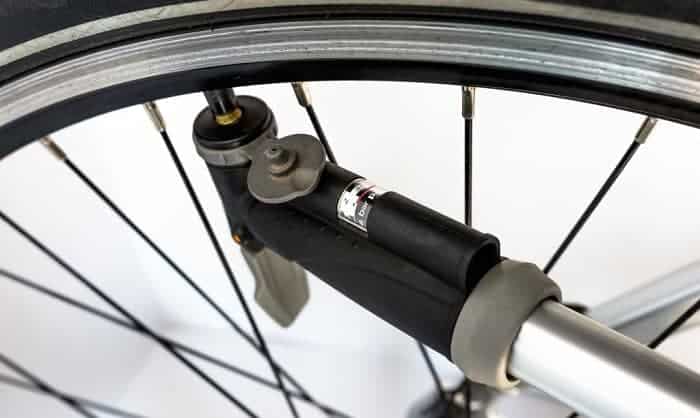Replacing your bike’s well-worn tires and purchasing a new one can be a confounding task. You should find a tire that fits perfectly to the size of your rim. Incompatible tires to bike rims could cause damage and put you in danger.
Typically, you only need to look at the size of your old tire, get the exact size then you are good to go. However, this is not always the case. You may overlook the numbers indicated on the old tire or get confused with the combination of inches and millimeters when you are looking for a new bike tire.
This is why you need to learn how to measure the size of your tires. It includes measuring the rim by diameter and the tire’s width by millimeters. To learn more about these steps, continue to read about how to measure a bike tire.
Table of Contents
What Do the Numbers Mean
Before the standardization of bike sizes, bike manufacturers had their own way of describing the measurement of their tires. A variety of wheel sizes are offered today for folding bikes, recumbents, and other specialty bicycles.
Understanding different bike sizes can come in handy. Today, we use the ISO standard notation for bike sizes introduced by the ETRTO (The European Tire and Rim Technical Organization). In this way, it is easier to determine the sizing of tires that can perfectly fit the rim of your bike.
The ISO is an ideal system that can eliminate inconsistencies in sizing. The ISO was able to standardize the tire sizes with numbers separated by a dash. The first portion has two digits indicating the width, while the other part has three digits showing the diameter.
The last three digits are the most crucial figure as it represents the bead diameter that will fit the tire to the rim. The ISO system makes a hassle-free bike tire measurement and comes in handy if you have no information about your bike tires.
However, if your bike tire does not have these key numbers, you will have to resort to the traditional measuring of your tires, which includes the following quick and easy steps:
- Prepare the tools needed to measure
- Determine the tire’s rim diameter
- Determine the tire’s width in millimeter
- Combining your measurements
Step-By-Step Process
- Prepare
Of course, preparation is the key to any endeavor, even the simplest ones. For this step, you will need to gather the following essential tools:
- Bike tire lever – tire levers out of hard plastic or steel and has a curved end that can be rounded or squared depending on the brand. Tire levers are used to slip under the lip of the bike tire. It can come with a small hook on the other end to secure leverage when deflating bike tires.
- Caliper – caliper is essential for getting the accurate width size of your tire. It is a sliding ruler with jaws designed to measure the diameter and thickness of your bike tire.
- Tape measure – you can use the tape measure to determine the tire’s width in millimeters.
After gathering the tools mentioned above, you are now ready to proceed to the next step.
- Determine the tire’s rim diameter
In this step, you should make sure that the bike is positioned. It means a great viewing angle of the tire with the proper posture while doing the work. This step is crucial so you will get the right and accurate measurements of your bike tire.
To do this, make sure your bike is securely propped against the wall or on its kickstand to avoid it from falling and hurting you while measuring the bike tire.
Use the tape measure to determine the length in millimeters from the center of the wheel to the inner edge of the tire. Multiply it by two to get the measurement of the diameter. You can stretch the tape measure in a straight line towards the edge of the bike tire for accuracy.
If you want the figures to correspond to the ISO standards, you need to tweak your technique a little. You can place the tape from the center of the bike wheel to the tire’s inner edges. Once you get the number, you can multiply it to get the bike tire diameter.
- Determine the tire’s width in millimeters
In this process, you may use the tape measure or a caliper. Measure across the tread from one side to the other. Keep in mind that when you buy a new tire, the ISO system will first list the width than the diameter.
Another option, you can get the tape measure and place it on the ground going across the tire’s tread in a straight and precise direction. The figures you get now correspond to the width in millimeters. If you want the number corresponding to the traditional system, you can convert the millimeters into inches.
Pro tip: You should take note that there is no single standard for the width of bicycle rims. It varies. There are rims intended for narrower and wider bike tires and have a wide range of sizes,from 13mm up to 29mm. Rim widths affect tire widths. You should also measure the internal rim to ascertain the minimum and maximum tire size it can support
- Combine the numbers
Now that you have the two key figures, you are ready to combine your measurements. In conventional tire measuring, you have to write the diameter before writing the dashed line, then the width. For the ISO system, the width should come first. It will then be the diameter.
Pro tip: The process may be simple as it seems to be, but the key to an excellent performing bike is compatibility. You should ensure that the wheel is highly compatible with the tire to avoid confusion. There are rims intended for wider tires. Tire widths depend on the internal width of the rim. It is impossible to have narrow tires on wide bike rims like the mountain bike even if it is the correct diameter.
Tire width sizes are also a non-exact measurement of the outside diameter of the rim with the tire fully inflated. The width of the internal rim is what you need to consider when choosing the right tire for your bike. When you purchase a new bike tire, you cannot go to the store and say you need a 26” tire because it does not tell the size of the tire which is compatible with your bike’s rim.
Conclusion
Measuring your bike tire is very easy. There are only four steps to follow and you are good to go. It includes preparing properly, getting the diameter, obtaining the width in millimeters, and combining all your measurements. You would not need any added skill to complete these steps. You just have to be accurate and precise to be able to do the job right.
We love to hear your thoughts. So, do not hesitate to comment below for additional insights and suggestions. Also, if you find this article helpful, you are very much welcome to like and share.

“Bike commuting should be the trend for the next few years, and it is a convenient and eco-friendly way for us to travel. And we are here to make it a bit less troublesome for people who want to maintain their vehicle for a long time. So, the content I expect to put out here is offering help for bikers who are facing issues with parts of their bikes once in a while. Let’s have fun and protect the environment together!”



